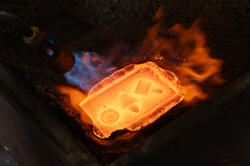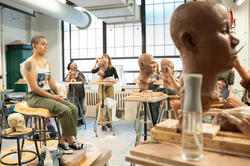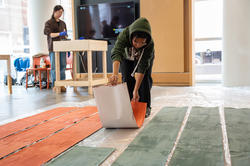Open to students in every major, Interdisciplinary Hot Casting explores a range of traditional and non-traditional techniques and mold materials.
Fall RISD Course Combines Age-Old Art Forms of Ceramics and Printmaking
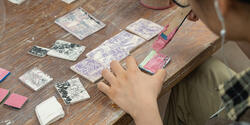
Students in a fall Ceramics studio are blending two artforms, ceramics and printmaking, to create new work that is both personal and profound. Developed by Ceramics Department Head Lesley Baker and taught by alum David Allyn MFA 03 CR, the course teaches students basic ceramics techniques such as slab rolling, coil building, and tile production, as well as printmaking skills like mono printing, stenciling, block printing, and stamping. The clay forms they produce essentially become blank canvases for prints.
“In this course, I want students to think about objects either sculpturally or conceptually and to create narratives that tie a series of objects together. And I’m very interested in cross-disciplinary intersection—that’s where all the interesting stuff happens,” says Allyn. “My class is equally filled with printmakers and ceramics majors. Everyone is learning from each other, and it’s one of the most active learning environments I’ve ever seen.”
After earning his MFA in Ceramics at RISD, Allyn made posters for friends’ bands. He realized that the inks were seeping through the screens and wondered if he could make prints using liquid ceramics. He has been experimenting with colored liquid ceramics ever since, using silkscreen-printing methods to produce ceramic work that is layered with color and imagery as a way to document the urban landscape.

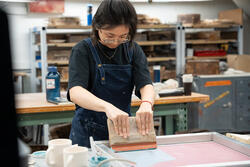
Once he earned approval from the Ceramics department for the new course, he turned an old storage space in the Metcalf Building studio into a working darkroom where students can use light-sensitive materials and “burn” screens using an ultraviolet light.
“Having the darkroom right here adds a nice immediacy to the process,” he says. “I’m a huge advocate of lost space recovery. I saw what had become a storage space for pallets and other unused materials as potential for activation.”
After putting clay through the slab roller to get the right thickness for the canvas, it has to air dry for at least an hour until it’s “leather hard.” Then the designs—photos, drawings, and other imagery—are created in Photoshop before they are turned into transparencies and then silkscreens.
Next they’re moved to the darkroom, where a pastelike colored clay is applied under UV light. The clay is later fired in the kiln, which brings the colors to life. Once fired, the pieces will never fade, Allyn notes, unlike prints on paper. “Photo-sensitive emulsion is a unique form of artmaking that is pushing the field here at RISD,” he says.


Students have been experimenting with printing on coffee mugs, tiles, and 3D sculptures, and much of the work they’re producing is functional and dishwasher safe. Printmaking major J Goldstein 27 PR, for example, is using four-color separation to imbue ceramic plates with images of birds from the Charles Darwin collection housed in the Natural History Museum, London. After grasping the basics of materials and techniques like stamping and embossing, they began exploring silkscreen printing.
“The final goal will be deciding what to do now that the students have mastered these techniques,” Allyn explains. “It’s interesting to see how their voices are translated through these materials. So far, no two people’s designs, aesthetics, or directions are the same, which is so great.”
Kaylee Pugliese
November 13, 2025
